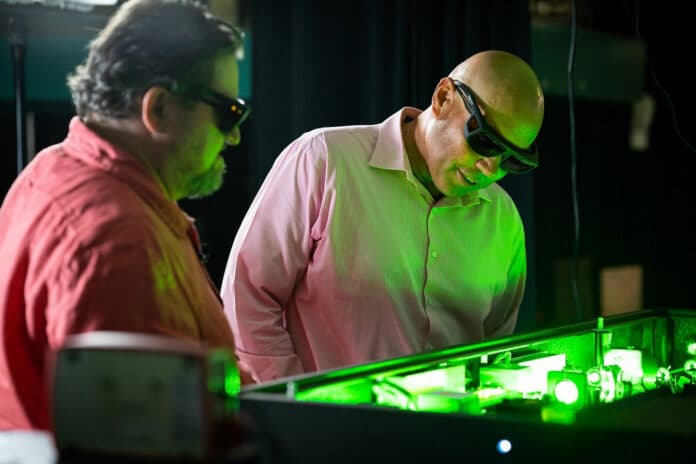The movement of electrons within a molecule moves so fast that it takes them just a few attoseconds to jump from one atom to another. So measuring such ultrafast processes is a daunting task.
Now, it is possible to measure time delays with zeptosecond (a trillionth of a billionth of a second) resolution, thanks to a novel technique developed by scientists at the Australian Attosecond Science Facility and the Centre for Quantum Dynamics of Griffith University in Brisbane, Australia. Using this novel interferometric technique, scientists could measure the time delay between extreme ultraviolet light pulses emitted by two isotopes of hydrogen molecules – H2 and D2 – interacting with intense infrared laser pulses.
This delay was found to be less than three attoseconds. They also found the cause of the delay: slightly different motions of the lighter and heavier nuclei.
High harmonic generation (HHG) is a method where molecules are exposed to powerful laser pulses to produce the actual light waves.
Extreme ultraviolet (XUV) radiation is released when an ion recombines with an electron extracted from a molecule by an intense laser field; then, the electron is accelerated by the same field. All individual atoms and molecules release HHG radiation differently, and the exact dynamics of the electron wavefunctions involved in this process affect the XUV HHG radiation’s intensity and phase.
A basic grating spectrometer can easily measure the spectrum intensity of HHG, but measuring the HHG phase is a far more challenging process. And the phase comprises the most essential data regarding the timing of several emission process processes.
Two copies of the wave with precisely controlled delays are produced to overlap (or interfere) with one another in a process known as interferometry to measure this phase. Depending on their latency and relative phase difference, they can interfere constructively or destructively.
An interferometer is a tool used to take this measurement. It is extremely challenging to create and maintain a stable, predictable, and finely tuneable delay between two XUV pulses in an interferometer for XUV pulses.
The study solved this problem by taking advantage of the Gouy phase phenomenon. The simplest molecule in nature, molecular hydrogen, comes in two distinct isotopes, which the scientists employed in their studies. The only nucleus mass difference between light (H2) and heavy (D2) hydrogen isotopes is between protons in H2 and deuterons in D2. The electronic composition and energies and everything else is the same.
Due to their larger mass, the nuclei in D2 move slightly slower than those in H2. Because nuclear and electronic motions in molecules are coupled, nuclear motion affects the dynamics of the electron wavefunctions during the HHG process resulting in a small phase shift ΔφH2-D2 between the two isotopes.
This phase shift is equivalent to a time delay Δt = ΔφH2-D2 /ω where ω is the frequency of the XUV wave. The Griffith scientists measured this emission time delay for all the harmonics observed in the HHG spectrum – it was nearly constant and slightly below three attoseconds.
Later, scientists used the most advanced theoretical methods to comprehensively model the HHG process in the two isotopes of molecular hydrogen. It also includes all degrees of freedom for nuclear and electronic motion at various levels of approximation.
The team was confident that their simulation accurately captured the critical characteristics of the underlying physical process because it accurately simulated experimental results. By varying the model’s parameters and levels of approximation, one can determine the relative significance of different effects.
Professor Igor Litvinyuk, Griffith University, School of Environment & Science, Nathan, Australia, said, “Because hydrogen is the simplest molecule in nature and it can be modeled theoretically with high accuracy, it was used in these proof-of-principle experiments for benchmarking and validation of the method.”
“In the future, this technique can measure ultrafast dynamics of various light-induced processes in atoms and molecules with unprecedented time resolution.”
Journal Reference:
- Mumta Hena Mustray et al. Attosecond Delays of High-Harmonic Emissions from Hydrogen Isotopes Measured by XUV Interferometer. Ultrafast Science. DOI: 10.34133/2022/9834102
